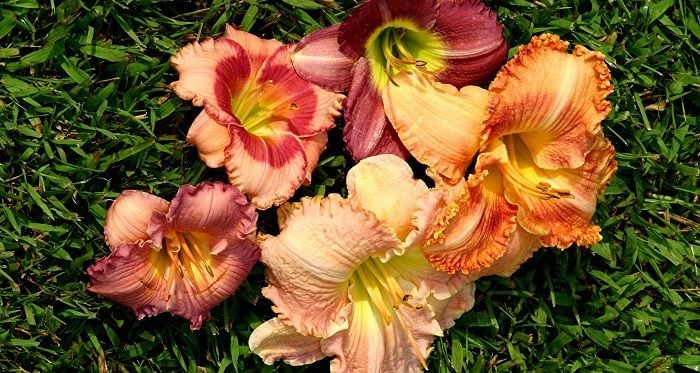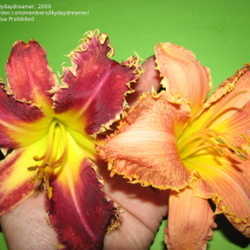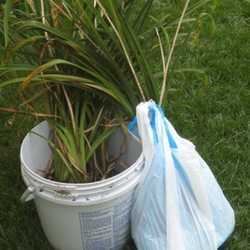Daylilies are beloved garden plants world-wide and just about anyone with a patch of sun is able to grow them. They're tough and forgiving, which makes them a good choice of beginners. These natives of Asia were once only available in shades of orange and yellow, but hybridizers and back-yard breeders have developed a rainbow of colors, in a vast number of shapes and heights. The species forms often escape cultivation and are seen naturalized in fields and along roadways, giving rise to the common name ‘ditch lily' that so many of us know them by.
Daylilies are members of the Hemerocallis genus. The name Hemerocallis comes from the Greek words ἡμέρα (hēmera) "day" and καλός (kalos) "beautiful". This is because the individual flowers generally last only 24 hours. Most varieties have stalks or ‘scapes' bearing buds (as daylily lovers know them) that produce multiple blossoms, so the colorful show usually lasts for several weeks. There are varieties that bloom at different times of the season, so by collecting, early, mid and late bloomers, you can prolong the show in your garden for a good part of the summer. There are also re-bloomers that put on a smaller show several weeks after the first one, so options are available.

These perennial plants spread by producing fleshy rhizomes from the parent plant and depending on how vigorous it is, can eventually grow into large mounds. The wild forms spread by rhizomes too, but they expand by runners and babies can pop up far from the parent, much to the dismay of gardeners who like things neat and tidy. Unless you have a large piece of property or a steep bank that needs stabilizing, the ‘ditch lily' forms might not work well for you. Check with your respective area to make sure that they are not listed on the Invasive Species list. Some areas do consider the wild forms serious pests to grazing and crop lands.
Plant daylilies in a well-drained location. Even though they like water (for their best show) they do not tolerate wet feet and boggy areas well. They like sun and need at least 6 hours of direct sunlight each day to produce a nice crop of blooms. Full sun all day is quite acceptable and once established, they're quite drought tolerant.
The beginning gardener can enter the world of daylilies inexpensively, with many cultivars priced at less than $10 (USD) for a double fan. A ‘double fan' is two shoots of leaves connected by the rhizomatous roots. Proper care and a good location will quickly see those two shoots reproduce and fill in, becoming a small clump in a couple of years. Advanced gardeners and those who have been seriously bitten by the daylily bug can feed their addiction for the newest introductions, which sometimes top $300 (USD) for a double fan. But there are thousands of cultivars and the vast majority is quite affordable on most gardeners' budgets. Paid subscribers to Dave's Garden can check out our friendly and active Daylily Forum, where like-minded addicts discuss the merits of each one and often trade fans among themselves.

The Garden Watchdog is an excellent place to search for mail order vendors and we have a large number of great companies that specialize in daylilies. They're easy to ship and generally handle the move well.
My daylily show starts about the first week in June and I'm always anxiously awaiting the first blooms from crosses I made the last year. Daylilies are simple to breed. Just break off the anther (male, pollen-bearing part) from one daylily and gently brush it on the central stigma. (The female part) A pod, containing seeds will grow when the flower drops off that takes about 40 days to mature. I generally chill the black seeds in the refrigerator for about three weeks before planting them. A small shoot resembling an onion will sprout and eventually grow into a daylily fan. Depending on your climate, blooms take between one and three years to appear. There are complex formulas that breeders use to cultivate specific traits, but I take the 'Forrest Gump' approach. "Life (or daylilies) is like a box of chocolates, you never know what you'll get." Although, I do like to cross fragrant daylilies with other fragrant ones because there is nothing more surprising or pleasant than a fragrant daylily early in the morning...and that trait is far to uncommon.
Our PlantFiles has its own mini database just for daylilies and we encourage you to browse the beautiful images shared by our members. They are some of the best eye-candy in the whole community! Some of the listings also have PlantScout vendors attached to make it easier if you want to purchase a particular cultivar.
If you haven't tried growing daylilies, this may be the right year to jump in, but you might find they're a lot like that famous potato chip....you can't quit with just one!

















